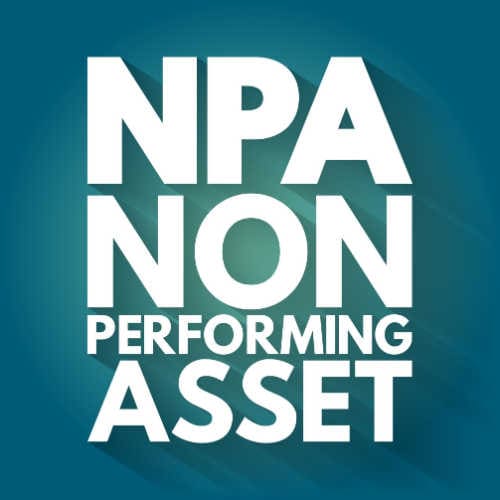Definition | Classification | How It Works | NPA Provisioning | NNPA Vs GNPA | Loan Vs Asset | Banks Concern | Affect On Borrowers | Affect On Economy | Other Effects | Factors Responsible | External Problems | Internal Issues | Minimizing NPA | SARFAESI Act | CIB | Settlement | Lok Adalats | Debt Recovery Tribunals | Conclusion
An asset is a resource controlled and owned by an economic entity or a business. For instance, a loan can be considered an asset for banks. Interests paid on loan is a source of revenue for financial institutions.
But, when the corporates and customers cannot pay interest, it forms a non-performing asset. Bank does not earn anything from it. So, according to RBI, NPA is an asset that generates no income.
Would you also like to read our ultimate guide on PMAY-HFA Urban?
A Clear Definition Of NPA

Non-performing assets are loans that are overdue for more than three months. In other words, an asset gets converted into a non-performing one when it stops generating income for financial institutions and banks.
RBI sent a circular in 2007 to help banks identify non-performing assets. However, non-performing investments can differ based on how long the resource has ceased producing revenues.
NPA Classification
Lenders set a grace period before categorising a non-performing asset. There are also sub-categories of this asset.
1. Standard Assets
NPAs are due for 3 to 12 months and involve normal risks.
2. Sub-Standard Assets
Non-performing assets that are due for over a year involve higher risk. Banks try to reduce the market value to let the borrower repay the amount.
3. Loss Assets
When the non-payment covers an extended period, it results in the formation of loss assets. Banks have to accept that there is no chance of recovering the loan. The balance sheet should record the loss.
4. Doubtful Debts
NPAs of this category are due for more than 18 months. Generally, banks are still determining the chance of getting back the loan. It will affect the risk profile of banks.
How Does An NPA Work?

Loans belong to the NPA category once the borrower has not repaid the loan for a considerable period. Lenders focus on some factors which have caused borrowers to make late payments. After 30 days, banks identify loans overdue. However, it is not the end of a particular grace period.
Banks try to collect outstanding debts with the foreclosure of assets and properties. For instance, a borrower may have applied for a second mortgage, which has become NPA. In this scenario, the bank will send a foreclosure notice on the home chosen as collateral.
The lender and the borrower should also be conscious of the performing assets. From the borrower’s perspective, failing to pay interest and non-performing purchases can adversely affect growth potential. It will also prevent borrowers from borrowing money in the future.
Banks need to have a record of non-performing assets, as many NPAs negatively affect their growth abilities and liquidity. NPAs are manageable, though it depends on the number of NPAs. If the non-performing assets continue to increase, they will pose a risk to the financial health.
What Is NPA Provisioning?
NPA provisioning is the amount saved by the bank from its profits in a particular quarter for NPAs. It is a way of providing for bad assets while maintaining healthy accounts. The category of assets can make a difference in provisioning. Provisioning norms are different for Tier I and Tier II banks.
NNPA Vs GNPA
Banks have to disclose the NPA numbers to RBI. Some critical metrics are helping you to understand the non-performing assets of banks. Moreover, banks create financial statements where they should reveal the NPA numbers.
- Gross non-performing asset- An absolute amount indicates the total value of the bank’s non-performing assets in a particular financial year.
- Net non-performing assets- NNPA deducts the provisions of banks from the GNPA. That is why net NPA shows the value of these assets after banks have made requirements.
Again, the NPA ratio is another factor relevant to non-performing assets. The total advances showed in percentage turn out NPAs. On the contrary, net NPA helps in calculating the NNPA.
Non-Performing Loan Vs Non-Performing Assets

A bank’s balance sheet shows NPAs when a borrower cannot pay the due amount for an extended period. NPL is also about the borrower’s inability to repay, but it is only for a short period.
The lender feels a financial burden due to the non-performing asset. On the contrary, loans in the banking sector are non-performing when the borrower has not made repayment for 90 days.
NPA affects the bank’s financial well-being. However, a bank finds a non-performing loan when there is no chance of recovering the due amount.
The repayment length helps in classifying NPAs. But, banks can sell NPLs to other banks, including investors.
Why Are Banks Concerned About NPAs?

Banks are worried about the accounts that risk turning into non-performing assets. They know that NPA can-
- Result in the loss of revenues
- Reflect a negative image of the financial institutions
- Leading to a higher rate of provisions
- Prompt RBI to take stern action
- Cause a crash in the stock market of the bank.
How Does NPA Affect Borrowers?
Non-performing assets affect the creditworthiness of borrowers and lower their CIBIL scores. Moreover, banks and other financial institutions will not quickly pay a loan to borrowers who have failed to repay the loan.
How Does NPA Affect The Overall Economy?
The increasing amount of NPA negatively affects the revenue stream of financial institutions and banks. Some banks have implemented measures to manage this asset. They may have reasonable reserves to balance the losses.
However, the non-performing loans deteriorate the bank’s financial health if that resource is consumed. So, NPA is a burden on the bank’s balance sheet.
Other Effects Of NPA
Due to the rise in non-performing assets, banks will find a lack of funds in the security market. Some banks refuse to lend money if they cannot find a way to recover their money.
Banks’ shareholders lose a significant amount of money. It is because banks may need help to survive in the competitive market.
You can also find a hike in interest rates, ultimately affecting loan applicants. Investors who take loans for industrial and infrastructural projects will face challenges.
Retail customers also feel the adverse effect because they must pay higher loan interest. So, these problems will have a significant impact on the overall economy of the country. There will be a reduced growth rate, while the inflation rate will go up due to the higher capital costs.
The trend will continue, and the situation may become more complicated. However, if a large amount of non-performing assets gets recovered, the Indian economy will become stronger.
Which Potential Factors Are Responsible For The Increasing Amount Of NPA?
The higher amount of NPA has resulted in an economic slowdown across the country. Due to slower economic growth and a higher interest rate, corporates have found it challenging to repay loans.
That is why it adds up to rising non-performing assets. Loans play an essential role in the country’s economy. So, bad loans naturally affect the financial status of the country. However, the economic cycle reversal is one of many reasons behind NPA.
External and internal factors contribute to a higher volume of NPA.
1. External Problems
The slowing growth rate of the global economy negatively affects. As the worldwide market is uncertain, it can affect the average number of exports of different goods. The corporate sector also finds difficulty in paying loans.
Other external issues include raw material price volatility, shortage of power, and environment-related permits.
2. Internal Issues
While looking back at the scenario of 2004-08, you could find that state-owned banks were responsible for asset quality deterioration. The primary reason behind it was their indiscriminate lending activities.
Bankers have claimed that a lack of proper loan appraisal processes and monitoring systems has caused the problem. For instance, investors who obtain loans for infrastructure projects (that continue for 20 to 30 years) need help to repay their loans.
Different Ways To Minimize The Volume Of A Non-Performing Asset
Banks have to assess those who have applied for loans meticulously. Please repay the loans to avoid a shortage of funds. It is essential to disclose the name of the defaulters. It will trigger fear and act as a deterrent. So, after providing loans, banks need to check the borrower’s capacity and determine the chance of going bankrupt. They can sell assets before the formation of non-performing assets.
Other methods for reduction of non-performing assets-
1. SARFAESI Act, 2002
It provides banks with three options for managing non-performing assets without approaching courts-
- Security enforcements
- Securitisation
- Asset reconstruction
SARFAESI deals with the due amount, which is more than Rs 1 Lakh. According to this Act, the amount below 20% of the interest and principal amount isn’t included. Moreover, banks have the right to notify you and request the release of the payment within 60 days.
2. Credit Information Bureau
As a third-party agency, CIBIL sends a database to banks to let them know borrowers’ financial status. Credit Information Bureau has a record of defaulter information. So, it shares the data with the bank and helps it to make a highly informed decision. However, banks need to pay a charge to get this service.
3. Compromise Settlement
It is another scheme to recover NPA (amounts to Rs 10 crores) through a non-discretionary process.
4. Lok Adalats
In 2001, RBI declared that Lok Adalats would help recover small loans (not more than five lakhs). This conflict resolution method is suited for both non-suit instances and lawsuits.
5. Debt Recovery Tribunals
In 1993, the Indian Parliament passed an Act to empower banks and financial institutions to collect debts of over Rs 10 Lakhs. DRT can manage more cases when compared to conventional courts. It will reduce delays in the overall processes.
Conclusion
Non-performing assets are not favourable for financial institutions and banks. More NPAs mean more non-functional loans, which do not generate income. The Indian government is trying to save the banks from these issues. Rigorous practices will help in making the right decision for approving loans. NPAs have grown in India in the last few years, so banks and the government must implement better practices.
